- Home›
- Healthy Living›
- 7 Yoga Exercises To Get Rid Of Puffy Eyes
7 Yoga Exercises To Get Rid Of Puffy Eyes
By: Priyanka Maheshwari Sun, 23 July 2023 10:17:07
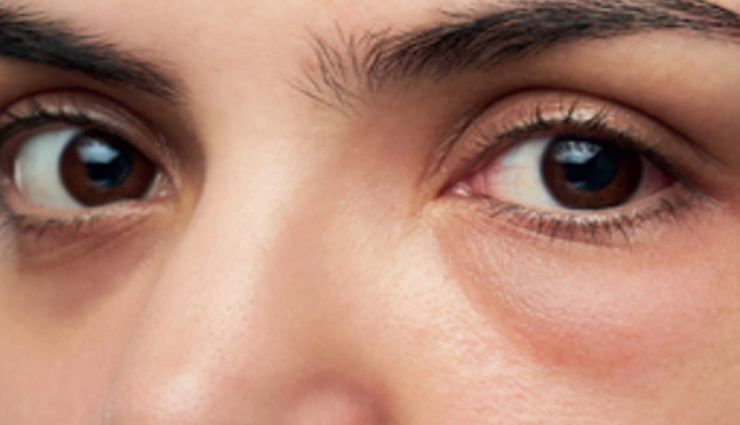
Are you frequently bothered by waking up with puffy eyes, leaving you with a tired and fatigued appearance despite getting a good night's sleep? The skin around the eyes is delicate and tends to retain fluid, resulting in unappealing puffiness. While there are numerous remedies available, yoga presents a natural and highly effective solution to alleviate puffiness and revitalize your eyes. Within this article, we will delve into seven straightforward yet potent yoga exercises that can aid you in eliminating puffy eyes, bringing back a radiant and rejuvenated look.
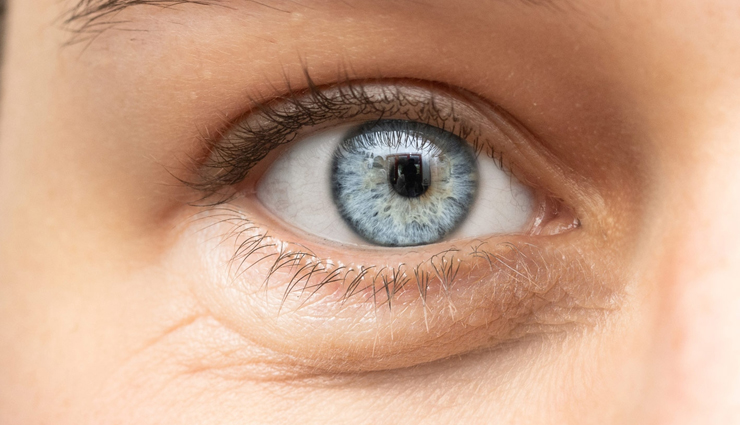
What Causes Puffy Eyes?
Fluid Retention: One of the primary causes of puffy eyes is the retention of fluid around the eye area. This can happen due to various reasons, including excessive salt intake, hormonal changes (especially during menstruation or pregnancy), dehydration, and certain medical conditions.
Lack of Sleep: Insufficient sleep or poor sleep quality can lead to puffy eyes. During sleep, the body works to flush out excess fluid and reduce inflammation, but inadequate rest can disrupt this process, causing fluid to accumulate around the eyes.
Allergies: Allergic reactions to allergens like pollen, pet dander, dust mites, or certain foods can trigger inflammation and cause the blood vessels around the eyes to dilate, resulting in puffy and red eyes.
Sinus Congestion: Nasal congestion and sinusitis can lead to puffy eyes due to increased pressure and inflammation in the sinus area, which can affect the blood flow around the eyes.
Aging: As we age, the skin around the eyes becomes thinner, and the muscles supporting it may weaken. This can lead to the accumulation of fat and fluid, causing the eyes to appear puffy.
Crying: Emotional tears can cause temporary puffy eyes due to the increased flow of fluid in the eye area.
Alcohol and Caffeine: Excessive consumption of alcohol and caffeine can dehydrate the body, leading to fluid retention and puffiness around the eyes.
Inflammation: Inflammatory skin conditions, such as dermatitis or eczema, can cause swelling and puffiness around the eyes.
Heredity: Puffy eyes can sometimes be a genetic trait, passed down through families.
Sun Exposure: Excessive sun exposure can lead to the breakdown of collagen and elastin in the skin around the eyes, contributing to puffiness.
Puffy eyes can sometimes be a sign of an underlying medical condition, such as thyroid disorders, kidney problems, or certain infections. If you notice persistent or severe puffiness around your eyes, it is crucial to seek advice from a healthcare professional to investigate any potential underlying health issues.
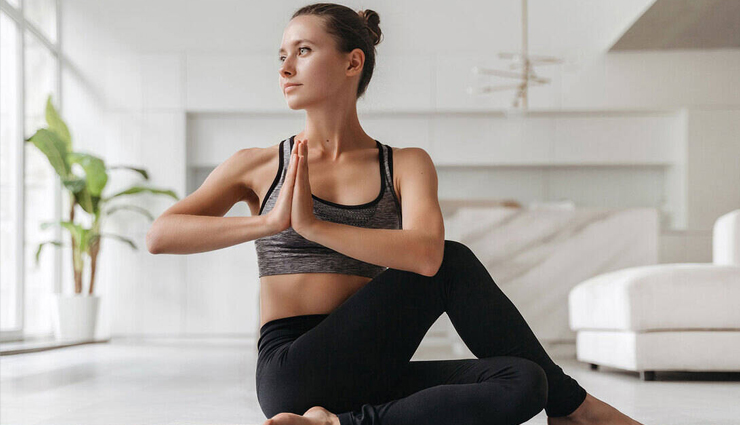
Yoga Exercises To Reduce Puffy Eyes
Is there anything that yoga can't address? Absolutely not. Yoga offers solutions for a wide range of issues, and it can be particularly effective in addressing puffy eyes. The beauty of yoga lies in its ability to target the root cause of problems, leading to a reduction in their occurrence. Certain yoga asanas that apply gentle pressure to the head and promote improved blood circulation work wonders for puffy eyes. These poses can help smooth out the appearance of under-eye bags and restore your eyes to their former radiant glory.
If you need assistance in choosing the right asana and understanding the proper method of practice, you've come to the right place. We have you covered with a selection of suitable yoga poses to alleviate puffy eyes. Simply scroll down to discover the transformative effects of yoga on your eye health and overall well-being.

Palming
Palming is a gentle and relaxing yoga exercise that alleviates eye strain and reduces puffiness. Here's how to do it:
- Sit comfortably with your back straight and shoulders relaxed.
- Close your eyes and take a few deep breaths to calm your mind.
- Rub your palms together vigorously until they feel warm.
- Place your warm palms over your closed eyes, ensuring there's no pressure on the eyeballs.
- Let the warmth and darkness soothe your eyes for 1-2 minutes, releasing tension and reducing puffiness.
Benefits Of Palming
Eye Relaxation: Palming provides a soothing and relaxing effect on the eyes. By covering the eyes with warm palms, the surrounding darkness helps to reduce strain and tension accumulated from extended screen time, reading, or other visual activities.
Reduces Eye Fatigue: Long hours of staring at screens or engaging in visually demanding tasks can cause eye fatigue. Palming helps to alleviate this fatigue by promoting blood circulation around the eyes and allowing them to rest and rejuvenate.
Eases Eye Strain: The gentle pressure of warm palms over closed eyes helps to release tension in the eye muscles, providing relief from eye strain caused by prolonged focus on one point.
Alleviates Puffiness: Palming can aid in reducing puffiness and swelling around the eyes. The warmth from the palms encourages blood flow, which can help to flush out excess fluid and reduce puffiness.
Calms the Mind: This practice involves taking a moment of stillness and darkness, which can have a calming effect on the mind. It helps to relax not only the eyes but also the mind and nervous system.
Improves Vision: While palming is not a direct vision improvement exercise, it indirectly supports better vision by reducing strain and promoting overall eye health. Relaxed eyes are less prone to vision issues caused by prolonged screen use or eye fatigue.
Relieves Eye Dryness: For those experiencing dry eyes, palming can help retain moisture around the eyes. The warmth from the palms stimulates tear production, reducing dryness and discomfort.
Stress Reduction: The act of palming encourages deep breathing and relaxation, aiding in stress reduction. It can be a helpful technique during moments of anxiety or when seeking a brief respite from daily stressors.
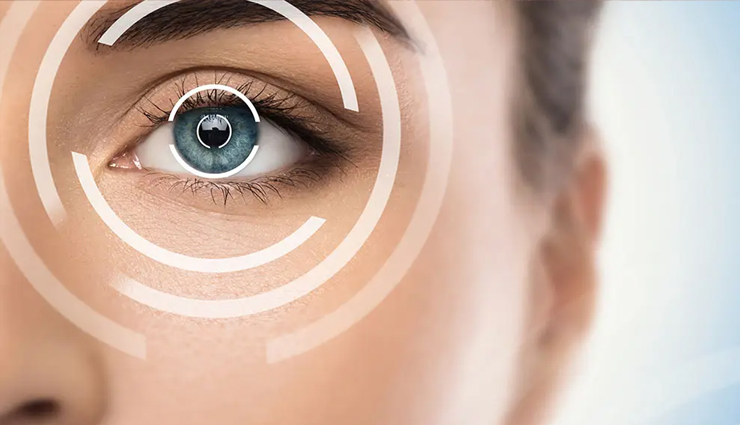
# Eye Circles
This exercise promotes blood circulation around the eyes, helping to reduce swelling and puffiness.
How To Do Eye Circles?
- Sit in a comfortable position, keeping your spine straight.
- Focus your gaze on a fixed point in front of you.
- Slowly move your eyes in clockwise circles for 5-6 rotations.
- Then, switch to counterclockwise circles for another 5-6 rotations.
- Blink a few times to relax your eye muscles.
Benefits Of Eye Circles
Improved Blood Circulation: Performing eye circles stimulates blood flow to the eye muscles and surrounding areas. Enhanced circulation helps deliver essential nutrients and oxygen to the eyes, promoting their overall health and function.
Reduced Eye Puffiness: The gentle motion of eye circles aids in reducing puffiness and fluid retention around the eyes. Improved circulation helps to drain excess fluids and reduce the appearance of swollen or puffy eyes.
Relieved Eye Strain: Eye circles help relax and stretch the eye muscles, relieving strain caused by prolonged periods of focusing on screens or other close-up tasks. This exercise can be especially beneficial for those who spend extended hours in front of digital devices.
Alleviated Dry Eyes: By encouraging blinking and gentle movement, eye circles can help combat dry eyes. Blinking helps spread tears evenly across the eyes, providing lubrication and reducing dryness and discomfort.
Enhanced Eye Flexibility: Regular practice of eye circles enhances the flexibility of the eye muscles, making it easier to adjust focus between different distances and reducing the likelihood of experiencing eye stiffness.
Reduced Eye Tension Headaches: Tension headaches often result from eye strain and tightness in the eye area. Eye circles can help alleviate this tension, reducing the frequency and intensity of eye-related headaches.
Improved Eye-Mind Connection: Eye exercises like eye circles can improve the connection between the eyes and the brain. The controlled eye movements stimulate neural pathways, enhancing eye-brain coordination.
Enhanced Concentration and Focus: Practicing eye circles requires focus and concentration, which can have positive effects on overall mental clarity and attentiveness.
Relaxation and Stress Relief: The deliberate and gentle movement of the eyes during eye circles promotes relaxation and can help reduce stress and anxiety.
Vision Maintenance: While eye circles may not directly improve vision, they contribute to maintaining healthy eyes and reducing the risk of vision-related issues caused by strain and neglect.
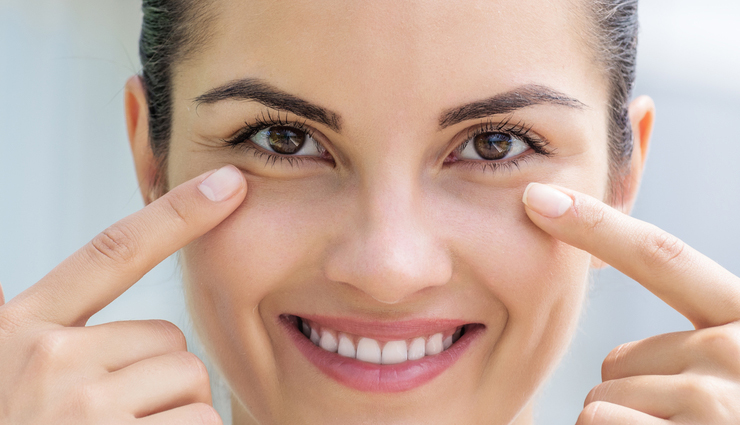
# Blinking
Blinking is a simple yet effective yoga exercise to moisturize and refresh the eyes, reducing puffiness and dryness.
How To Do Blinking?
- Sit comfortably and close your eyes.
- Begin to blink your eyes rapidly for about 30 seconds.
- After 30 seconds, close your eyes and take a few deep breaths to relax.
- Repeat this process three times.
Benefits of Blinking
Eye Lubrication: One of the primary purposes of blinking is to spread tears across the surface of the eyes. Tears contain essential lubricants and nutrients that keep the eyes moist and prevent dryness. Proper lubrication is vital for maintaining clear vision and preventing discomfort associated with dry eyes.
Removal of Debris: Blinking helps to clear the eyes of dust, debris, and other foreign particles that may come into contact with the eyes during daily activities. Each blink helps to flush out irritants and protect the delicate surface of the eyes.
Reduction of Eye Strain: Consistent blinking helps to reduce eye strain caused by extended periods of focusing on screens or other near work. Blinking regularly ensures that the eyes stay hydrated and relaxed, which can help alleviate eye fatigue and discomfort.
Improved Visual Clarity: Blinking momentarily interrupts visual input, allowing the eyes to rest and reset. This brief pause in visual processing helps to maintain visual clarity and prevent visual fatigue, especially during activities that require sustained attention.
Protection from Bright Light: In the presence of bright light, blinking helps protect the eyes from potential damage caused by excessive exposure to light and harmful UV rays.
Eye Health Maintenance: Proper blinking contributes to overall eye health by ensuring that the eyes receive a consistent supply of oxygen and nutrients. Good eye health is essential for maintaining clear vision and preventing eye-related issues.
Eye-Brain Connection: Blinking is an integral part of the eye-brain connection. The act of blinking sends signals to the brain, promoting communication and coordination between the eyes and the central nervous system.
Stress Reduction: Blinking can have a calming effect on the mind and body. During moments of stress or anxiety, conscious deep blinking can help relax the facial muscles and promote a sense of calm.
Social Interaction: Blinking is also a crucial part of non-verbal communication. In social situations, blinking helps convey emotions and signals comfort, attentiveness, or sincerity.
Improved Concentration and Productivity: Frequent blinking, especially during screen use, can enhance concentration and productivity by reducing eye strain and maintaining visual comfort.
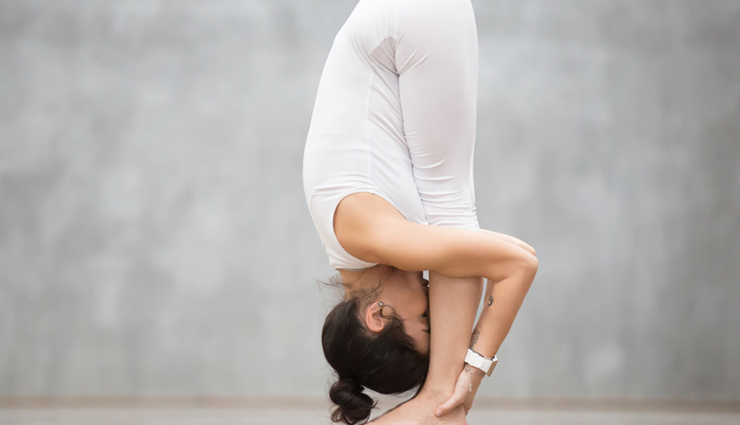
# Forward Bends
Forward bends stimulate blood flow to the face and head, reducing fluid retention around the eyes.
How To Do Forward Bends?
- Stand with your feet hip-width apart.
- Inhale deeply and lengthen your spine.
- Exhale as you bend forward from the hips, reaching your hands towards your feet or the ground.
- If you can't reach the floor, you can bend your knees slightly.
- Hold the pose for 30 seconds, breathing deeply.
- Slowly rise back up on an inhale.
Benefits of Forward Bends
Spine Flexibility: Forward bends gently stretch the entire length of the spine, promoting flexibility and mobility in the vertebral column. This can help alleviate tension and discomfort in the back and improve posture.
Hamstring and Hip Flexibility: As you fold forward, your hamstrings and hip flexors are stretched, enhancing flexibility in these muscle groups. Regular practice of forward bends can lead to increased ease in activities that involve bending at the hips, such as walking and sitting.
Calming and Stress Reduction: Forward bends are considered calming and soothing postures. The act of folding forward promotes relaxation and can help reduce stress and anxiety. It also activates the parasympathetic nervous system, which induces a state of rest and relaxation.
Improved Circulation: When you fold forward, blood circulation to the brain is momentarily reduced. Upon releasing the pose, fresh blood flows back to the brain, providing a rejuvenating effect and enhancing overall circulation.
Massage to Abdominal Organs: Forward bends gently massage and stimulate the abdominal organs, including the liver, kidneys, and intestines. This can aid in digestion, detoxification, and improving organ function.
Therapeutic for Digestive Issues: Certain forward bends can specifically target digestive issues by applying gentle pressure to the abdomen and promoting a calming effect on the digestive system.
Mind-Body Connection: Forward bends require a certain level of concentration and focus on the breath and body alignment. This cultivates a stronger mind-body connection, enhancing awareness and mindfulness during the practice.
Relief from Mild Depression and Fatigue: The inversion aspect of some forward bends, where the head is positioned below the heart, can help combat mild depression and fatigue by enhancing blood flow to the brain and improving mood.
Grounding and Centering: Forward bends often involve folding inward and downward, creating a sense of grounding and introspection. This can be particularly beneficial for individuals seeking to find inner calm and stability.
Cooling and Balancing: In contrast to backbends that are energizing, forward bends have a cooling and calming effect. They help balance the body and mind, making them ideal for a gentle practice or as a counterpose to more vigorous poses.
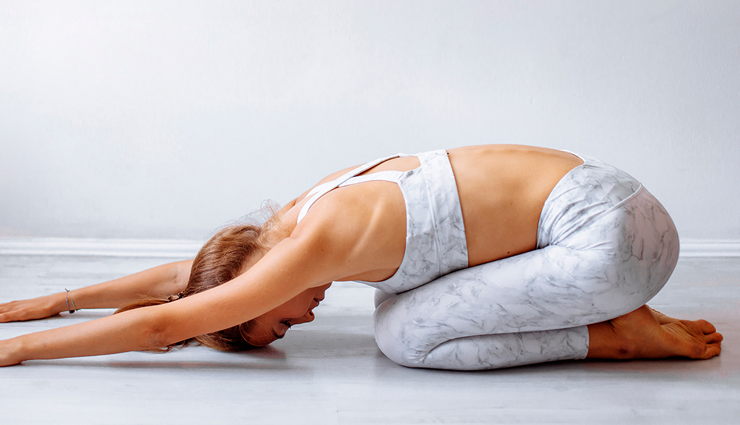
# Child's Pose
Child's Pose is a calming and restorative yoga posture that encourages blood circulation to the face and reduces eye puffiness.
How To Do Child's Pose?
- Kneel on the floor with your big toes touching and knees hip-width apart.
- Sit back on your heels and lower your torso forward, reaching your arms in front of you.
- Rest your forehead on the mat and relax your neck.
- Hold the pose for 1-2 minutes, breathing deeply and feeling the tension release around your eyes.
Benefits of Child's Pose
Stress Relief: Child's Pose is a deeply calming and grounding posture. The forward folding and gentle pressure on the forehead can help activate the parasympathetic nervous system, promoting relaxation and reducing stress and anxiety.
Spinal Flexibility: The gentle stretch in the back and spine encourages flexibility and mobility in the vertebral column. This can provide relief from tension and discomfort caused by long periods of sitting or standing.
Hip and Thigh Stretch: The position of the knees wide apart in Child's Pose stretches the hips and inner thighs, releasing tension in these areas and promoting flexibility.
Lower Back Relief: The elongated position of the spine and the forward fold can alleviate mild lower back pain and discomfort, making it an excellent pose for those with tightness in the lumbar region.
Digestive Health: Child's Pose can compress the abdomen slightly, which can stimulate and massage the internal organs, aiding in digestion and relieving bloating and gas.
Opens the Shoulders: Stretching the arms forward in Child's Pose can help open the shoulders and release tension in the upper back and neck.
Breathing and Mindfulness: The resting position of the head on the mat and the focus on the breath in Child's Pose can promote mindfulness and create a sense of inner peace and relaxation.
Gentle Inversion: Child's Pose is considered a mild inversion as the head is positioned below the heart. This can increase blood flow to the brain, provide a gentle stretch to the back of the neck, and promote relaxation.
Therapeutic for Fatigue: The restorative nature of Child's Pose makes it beneficial for those experiencing fatigue or feeling overwhelmed. It can help replenish energy and provide a moment of rest during a yoga practice.
Emotional Release: Child's Pose can be a comforting and nurturing posture. As you fold into yourself, it may encourage emotional release and a sense of surrender.
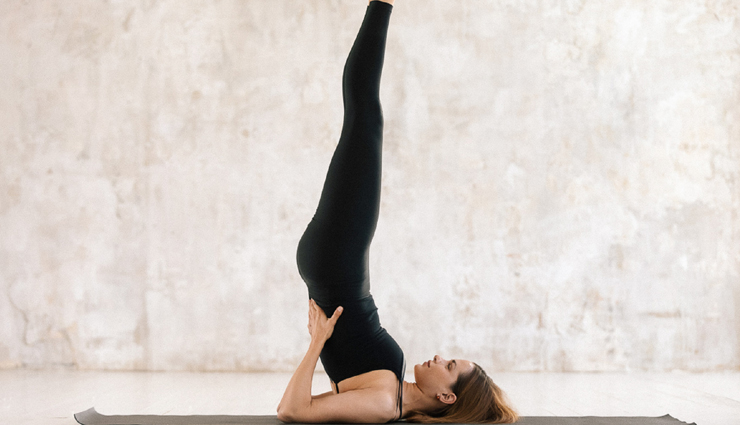
# Shoulder Stand
The Shoulder Stand is an inverted yoga pose that improves blood flow to the face, reducing puffiness and dark circles.
How To Do Shoulder Stand?
- Lie on your back with your arms beside your body and palms facing down.
- Lift your legs and hips off the ground, supporting your lower back with your hands.
- Keep your legs straight and extend them upwards, perpendicular to the floor.
- Hold the pose for 30 seconds to 1 minute, breathing deeply.
- Slowly lower your legs back down with control.
Benefits of Child's Pose
Improved Circulation: Shoulder Stand is an inverted pose, meaning the heart is positioned higher than the head. This reversal of blood flow encourages venous blood to return to the heart, enhancing circulation and blood oxygenation.
Boosts Immunity: The increased circulation and lymphatic drainage in Shoulder Stand can help stimulate the immune system, supporting the body's ability to fight off infections and illnesses.
Calming and Relaxing: While it's an energizing pose, Shoulder Stand also has a calming effect on the nervous system. It can help reduce stress, anxiety, and mild depression by activating the parasympathetic nervous system.
Thyroid Stimulation: Shoulder Stand is believed to stimulate the thyroid gland, which plays a crucial role in regulating metabolism and overall hormonal balance.
Tones and Strengthens Muscles: This pose engages various muscles, including the shoulders, arms, core, and legs, helping to tone and strengthen the entire body.
Improved Digestion: The inverted nature of Shoulder Stand can aid in digestion by massaging and stimulating the abdominal organs, promoting better digestion and reducing bloating.
Enhanced Shoulder and Neck Flexibility: Shoulder Stand involves lifting the body weight onto the shoulders, which can improve flexibility and strength in the shoulders, neck, and upper back.
Respiration Benefits: The expanded chest cavity and increased lung capacity in Shoulder Stand can improve respiratory function, benefiting those with mild respiratory issues.
Centering and Focus: Maintaining balance and stability in Shoulder Stand requires concentration and focus, fostering a sense of inner calm and mindfulness.
Energetic Flow: According to yogic traditions, Shoulder Stand is considered a pose that redirects energy (prana) from the lower to the upper body. This can help balance and harmonize the flow of energy throughout the body.
It's important to practice Shoulder Stand with proper alignment and under the guidance of an experienced yoga instructor, especially if you are new to inversions or have any neck or shoulder issues. Avoid this pose if you have high blood pressure, neck injuries, or certain medical conditions.
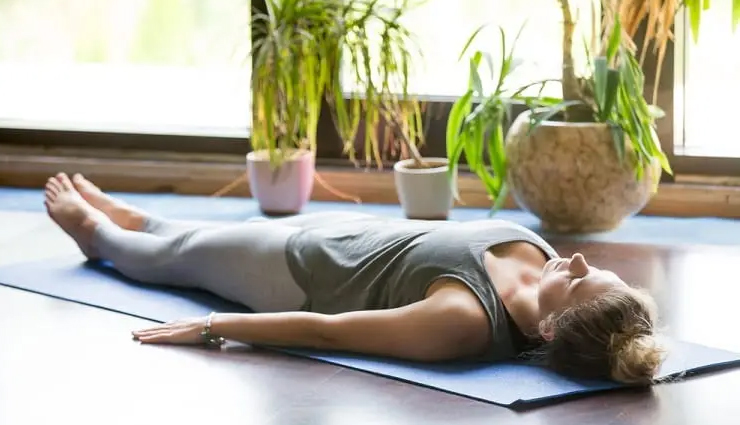
# Corpse Pose
Corpse Pose is a final relaxation posture that allows your body and eyes to rest, reducing any remaining puffiness.
How To Do Corpse Pose?
- Lie flat on your back with your legs extended and arms by your sides, palms facing up.
- Close your eyes and focus on your breath, letting go of any tension or stress.
- Relax in this pose for at least 5-10 minutes, allowing your eyes to feel rejuvenated and refreshed.
Benefits of Corpse Pose
Deep Relaxation: Corpse Pose is the ultimate relaxation posture in yoga. It allows the body to rest completely, promoting a state of deep relaxation and rejuvenation.
Stress Reduction: By releasing physical tension and calming the mind, Corpse Pose is highly effective in reducing stress and anxiety. It activates the parasympathetic nervous system, triggering the body's natural relaxation response.
Integration and Absorption: After an active yoga practice, Savasana allows the body to assimilate the benefits of the previous poses. It gives the body time to integrate the energetic shifts and realign itself.
Mental Clarity and Focus: During Corpse Pose, the mind is encouraged to quiet down and find stillness. This practice cultivates mental clarity, improves focus, and helps clear the mind of clutter.
Better Sleep: Practicing Corpse Pose can have a calming effect on the nervous system, making it an excellent way to prepare the body for a restful night's sleep.
Balances Blood Pressure: Savasana is known to help balance blood pressure, as it reduces stress and promotes a more balanced autonomic nervous system.
Mind-Body Connection: Corpse Pose encourages a heightened sense of awareness of the body and breath. This fosters a deeper mind-body connection and a sense of inner harmony.
Heart Health: The relaxation achieved in Corpse Pose is beneficial for the cardiovascular system. It reduces the heart rate, allowing the heart to rest and recover.
Muscle Recovery: This posture helps relax and release tension in the muscles, facilitating muscle recovery after a challenging yoga practice or workout.
Cultivates Surrender: Corpse Pose teaches surrender and letting go. It invites practitioners to release physical and mental attachments, creating space for inner peace and acceptance.





